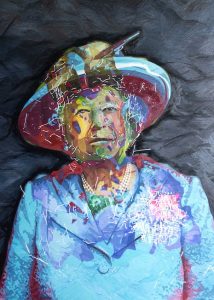New York: If you thought that a piece of art needs to be crafted or drawn by the human hands, it’s time to rethink. At a New York-based art gallery, the paintings created by a humanoid robot—Ai-Da—will change your perception. In fact, a portrait of English mathematician Alan Turing became the first artwork by a humanoid robot to be sold at auction. The 2.2 metre (7.5 feet) portrait, titled A.I. God. Portrait of Alan Turing, by Ai-Da fetched a whopping $1 million at an exhibition by Sotheby’s last Thursday. The organizers of the exhibition confirmed that at least 27 bids were placed on the work, reported the Guardian.
Know the hi-tech artist
The robot is named after Ada Lovelace, the first computer programmer. Ai-Da is the world’s first humanoid AI artist. It has been created by an Oxford-based art dealer, Aidan Meller. The robot is equipped with cameras that function as its eyes, a robotic arm for painting, and an AI-powered brain. Her AI brain helps her to “see” and recreate anything that’s kept in front of her.



How did the robot create the artwork?
The robot may not have emotions or ideas of her own, but thanks to the programming, she can analyze visual data. Thereafter, she transforms the visual data into art. Ai-Da, which uses AI to speak, said: “The key value of my work is its capacity to serve as a catalyst for dialogue about emerging technologies.” Ai-Da added that a “portrait of pioneer Alan Turing invites viewers to reflect on the God-like nature of AI and computing while considering the ethical and societal implications of these advancements.”
We will see the new Michelangelo or Raphael in our lifetime.
The portrait of Alan Turing created by Ai-Da became the first robot-created artwork to be auctioned, selling for $1.08 million at Sotheby’s. pic.twitter.com/NRe2o96PRB
— Culture Explorer (@CultureExploreX) November 9, 2024
‘Should robots be creating art?’
According to reports, the painting was even shown at a United Nations AI summit earlier this year. “I do not have subjective experiences; I am dependent on computer programs. Although I’m not alive, I can still create art,” she had told at the UK Parliament last year.
Her statement left lawmakers to ponder whether machines were stepping into areas once thought to be exclusively human. Her success also puts forth questions like: ‘Should robots be creating art? and if so, what does that mean for human artists?’


